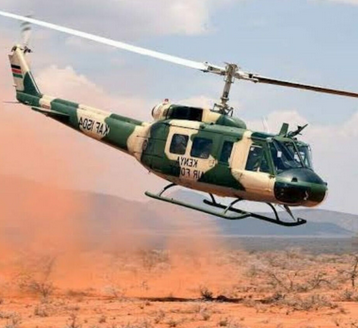 A Kenya Airforce helicopter attempts toland. /FILE
A Kenya Airforce helicopter attempts toland. /FILE
On April 18, 2024, tragedy struck the nerve of the Kenya Defence Forces when a Bell UH-1H-II Huey helicopter crashed shortly after takeoff in Elgeyo Marakwet, killing the then Chief of Defence Forces General Francis Ogolla and nine others.
The official report from the Ministry of Defence released Friday, April 11, 2025, revealed that the crash was caused by a mechanical failure known as an Engine Compressor Stall (Surge), a term unfamiliar to many but one that can have devastating consequences in aviation.
This article shares insights on the engine complexities that malfunctioned, resulting to the chopper losing power and eventually tumbling down, killing the CDF and his entire entourage save for a photographer.
What Is an Engine Compressor Stall?
A compressor stall or surge is a sudden disruption in the normal flow of air through the engine.
Helicopter and jet engines rely on a steady stream of air entering the front, being compressed, mixed with fuel and ignited to produce thrust or lift. This airflow must remain stable and continuous.
However, if there is any interruption or reversal of airflow due to mechanical failure, damage, or sudden changes in engine pressure, the engine can "stall" or "surge".
This means the engine stops working efficiently, or entirely, and in the worst-case scenario, may lose power altogether.
In the case of General Ogolla’s flight, the engine compressor surge caused a complete power loss, leading to a crash just over a minute after takeoff, the military report shows.
How does it happen?
Blocked or damaged airflow paths
Dust, debris, birds, or damaged blades can disrupt airflow into the engine, causing uneven pressure or airflow reversal.
Fuel flow issues
An incorrect air-to-fuel ratio, often too much fuel or not enough air can lead to unstable combustion, triggering a stall.
Mechanical failure
Internal engine components, especially in older aircraft, may wear out or malfunction.
KDF's Huey helicopter had a newly overhauled engine installed just four months before the crash.
However, the post-crash reading of the Measured Gas Temperature (MGT) showed a dangerous spike to 914°C, indicating extreme engine stress.
Pilot inputs or sudden manoeuvers
Sudden changes in engine power or blade angle, especially during takeoff or steep climbs, can momentarily disrupt airflow to the engine, potentially causing a stall.
Weather or environmental conditions
Though ruled out in the Ogolla incident, extreme heat, high altitudes or flying through turbulent conditions can contribute to compressor stalls.
What happens during a stall or surge?
When a compressor stall occurs, passengers or pilots often describe hearing a loud “bang”, a drop in engine noise and possibly even flames from the engine exhaust.
In helicopters, this is followed by loss of engine power, drop in rotor Revolutions Per Minute (RPM) , Low-RPM warning alarms, yawing or spinning of the aircraft and inability to maintain lift or altitude.
In the KDF Huey crash, these exact signs were observed. Witnesses reported a loud bang from the engine area, followed by a sudden loss of power, a left yaw, and then the helicopter crashing into a farm and bursting into flames.
Could it have been prevented?
According to the official report, the helicopter had undergone regular maintenance, including a recent 150-hour inspection and multiple system checks between January and April 2024.
The engine had also been overhauled and installed in December 2023.
All maintenance logs were clear and fuel and oil samples showed no contamination.
However, even with scheduled servicing, mechanical failures can still occur, particularly in high-stress environments and older airframes.
The Bell UH-1H-II Huey model, though still in operational use globally, was originally developed in the 1950s, and relies heavily on routine updates and careful part replacements.
What happens after a stall in flight?
In single-engine helicopters like the UH-1H-II, an engine failure leaves the pilot with only one option - autorotation.
This is an emergency descent method where the rotors spin freely without engine power, allowing the pilot to glide the aircraft to the ground.
However, autorotation is extremely difficult to execute, especially if the failure happens at low altitude or over uneven terrain.
The crash happened just 1.3 nautical miles from the takeoff point, meaning the pilots had very little time and space to recover.
Despite attempts to land in a clear zone, the helicopter lost positive control and hit the ground.
Lessons and reforms
Following the incident, the Kenya Air Force reviewed and updated its Standard Operating Procedures (SOPs) to help detect early engine abnormalities and reduce risk during high-profile missions.
While compressor stalls are not common, they serve as a stark reminder of how even well-maintained aircraft can suffer critical failures, and why constant vigilance in both mechanical and operational planning is essential, especially when lives at the highest levels of national leadership are involved.











